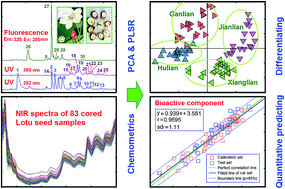当前位置:
X-MOL 学术
›
Anal. Methods
›
论文详情
Our official English website, www.x-mol.net, welcomes your feedback! (Note: you will need to create a separate account there.)
The combination of NIR spectroscopy and HPLC chromatography for differentiating lotus seed cultivars and quantitative prediction of four main constituents in lotus with the aid of chemometrics
Analytical Methods ( IF 3.1 ) Pub Date : 2017-10-16 00:00:00 , DOI: 10.1039/c7ay02021j Ying Guo 1, 2, 3, 4, 5 , Xiaoxiao Ding 2, 4, 5, 6 , Yongnian Ni 1, 2, 3, 4, 5
Analytical Methods ( IF 3.1 ) Pub Date : 2017-10-16 00:00:00 , DOI: 10.1039/c7ay02021j Ying Guo 1, 2, 3, 4, 5 , Xiaoxiao Ding 2, 4, 5, 6 , Yongnian Ni 1, 2, 3, 4, 5
Affiliation

|
Lotus has been widely cultivated and consumed in Asia, Oceania and America, and it is not only used as an ornamental plant but also as a dietary staple. In this work, fingerprinting techniques based on NIR spectroscopy and HPLC chromatography were used to discriminate four important kinds of lotus seed cultivars, Xianglian, Jianlian, Ganlian and Hulian. By the use of the NIR spectra and the aid of genetic algorithm-partial least squares (GA-PLS) and principal component analysis (PCA), cored lotus seed samples were successfully discriminated into four cultivars. High performance liquid chromatographic (HPLC) characteristic peaks detected at different wavelengths can also be used for PCA analysis to differentiate the lotus seed cultivars. Furthermore, quantitative prediction analysis of total sugar, total polysaccharide, liensinine and rutin in cored lotus seed (liensinine and rutin are mainly in lotus plumule) can be successfully performed with the use of the combined data matrix of 30 common characteristic HPLC peaks and 37 GA-PLS selected NIR spectral variables (wavelengths). The results suggested that the combination of NIR and HPLC supported by chemometrics is suitable for the discrimination of the plant cultivars and quantitative prediction of the active constituents in lotus seed samples.
中文翻译:

近红外光谱法和高效液相色谱法相结合鉴别莲子品种并借助化学计量学定量预测莲子中的四种主要成分
莲花在亚洲,大洋洲和美洲已经广泛种植和消费,它不仅被用作观赏植物,而且还被用作饮食的主食。在这项工作中,基于近红外光谱和HPLC色谱的指纹技术被用来区分四种重要的莲子品种:香莲,剑连,甘莲和呼连。通过使用近红外光谱和遗传算法-偏最小二乘(GA-PLS)和主成分分析(PCA),成功地将带芯荷花种子样品区分为四个品种。在不同波长处检测到的高效液相色谱(HPLC)特征峰也可用于PCA分析,以区分莲子品种。此外,对总糖,总多糖,使用30个共同的特征性HPLC峰和37个GA-PLS选定的NIR光谱变量(波长)的组合数据矩阵,可以成功地完成带芯莲子中的莲心碱和芦丁(莲心碱和芦丁主要存在于莲蓬中)。结果表明,化学计量学支持的近红外光谱和高效液相色谱的结合适用于植物品种的鉴别和莲子样品中活性成分的定量预测。
更新日期:2017-11-23
中文翻译:

近红外光谱法和高效液相色谱法相结合鉴别莲子品种并借助化学计量学定量预测莲子中的四种主要成分
莲花在亚洲,大洋洲和美洲已经广泛种植和消费,它不仅被用作观赏植物,而且还被用作饮食的主食。在这项工作中,基于近红外光谱和HPLC色谱的指纹技术被用来区分四种重要的莲子品种:香莲,剑连,甘莲和呼连。通过使用近红外光谱和遗传算法-偏最小二乘(GA-PLS)和主成分分析(PCA),成功地将带芯荷花种子样品区分为四个品种。在不同波长处检测到的高效液相色谱(HPLC)特征峰也可用于PCA分析,以区分莲子品种。此外,对总糖,总多糖,使用30个共同的特征性HPLC峰和37个GA-PLS选定的NIR光谱变量(波长)的组合数据矩阵,可以成功地完成带芯莲子中的莲心碱和芦丁(莲心碱和芦丁主要存在于莲蓬中)。结果表明,化学计量学支持的近红外光谱和高效液相色谱的结合适用于植物品种的鉴别和莲子样品中活性成分的定量预测。


























 京公网安备 11010802027423号
京公网安备 11010802027423号